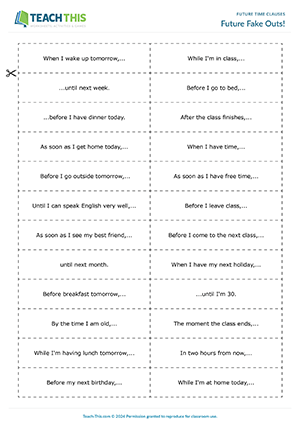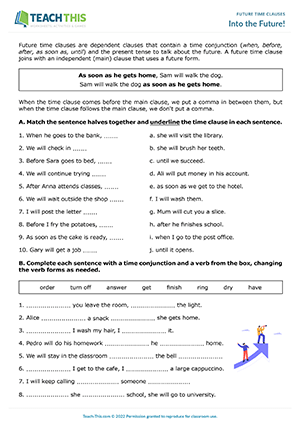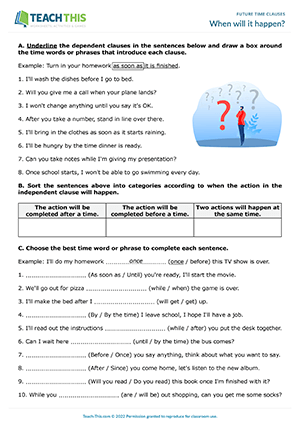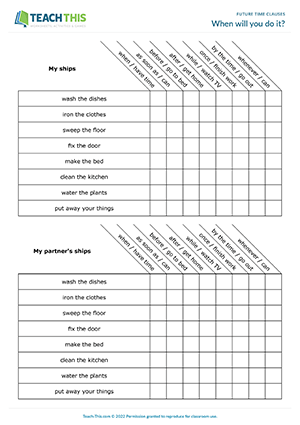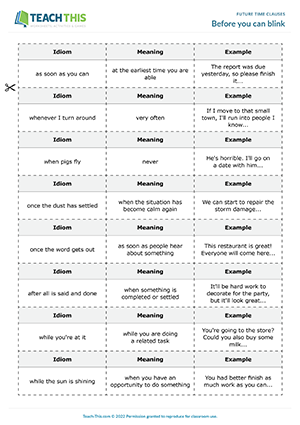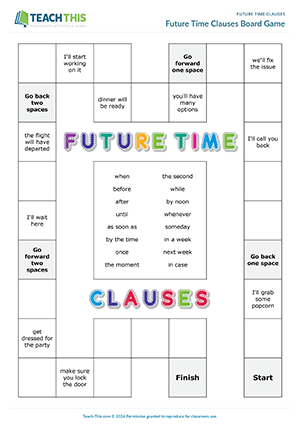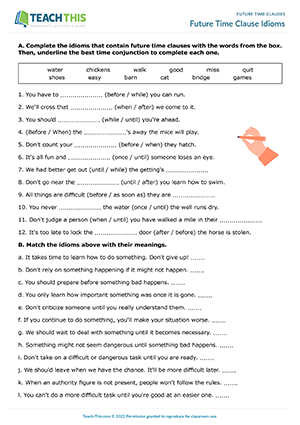In this fun future time clauses game, students use future time clauses to form true or false sentences that trick other students. In groups, students take turns picking up a card and making a true or false sentence using the future time clause on the card, e.g. 'When I wake up tomorrow, I'm going jogging.' Each group member then asks the student a follow-up question to determine whether they are lying or telling the truth, e.g. 'Where are you going jogging?' After the questions have been answered, each group member guesses whether the statement is true or false. The student then reveals the answer. The group members who guessed correctly each score one point. The next student then picks up a card, and so on. The student with the most points at the end of the game wins.
This comprehensive future time clauses worksheet helps students practice creating sentences with a variety of future time clauses. First, students read about future time clauses and look at examples. Next, students match sentence halves together and underline the future time clause in each sentence. After that, students complete each sentence with a time conjunction and a verb from a box, changing the verb forms as needed. Students then put words in order to create sentences with future time clauses. Following that, students complete sentences, choosing two verbs for each sentence and putting them in the correct form. Lastly, students complete future time clause sentences with their own ideas and discuss them with partner to see if any of them are the same.
In this useful future time clauses worksheet, students practice using future time clauses to indicate when a future action will take place. First, students underline dependent clauses in sentences containing future time clauses and draw a box around the time words or phrases that introduce each clause. Next, students sort the sentences into categories according to when the independent clause will happen. After that, students choose the best time word or phrase to complete each sentence. Students then move on to correct errors in sentences containing future time clauses. Finally, students rewrite sentences with a future time clause that contains the words shown in brackets.
In this free future time clauses game, students play Battleships by asking and answering questions that use future time clauses. Students begin by marking four ships on their grid. Students then take turns choosing a square on their partner's grid. However, instead of giving a grid reference, the student makes a yes/no question using the corresponding household chore and future time clause, e.g. 'Will you wash the dishes when you have time?' Their partner listens to the question, looks at their grid and answers according to whether it is a hit or miss. If it's a hit, their partner replies positively, e.g. 'Yes, I will.' If it's a miss, they reply negatively, e.g. 'I'm sorry, I can't.' The student then marks the square with a 'H' for hit or 'X' for miss. The first student to sink all their partner's ships wins the game.
In this engaging future time clauses game, students match future time clause idioms with their meanings and form sentences with the idioms. In groups, students take turns turning over one future time clause idiom card and one meaning card. If the future time clause idiom and meaning match, the student goes on to turn over an example sentence card. If a student turns over a three-card set that contains a future time clause idiom, its meaning, and a main clause that can be combined with the idiom to make an example sentence, the student reads out the example sentence combining the idiom, keeps the set and has another turn. If at any point a card doesn't match, the cards are turned back over, keeping them in the same place. Play continues until all 16 sets have been found. The student with the most sets of cards at the end of the game is the winner.
In this enjoyable future time clauses board game, students practice forming sentences with future time clauses. Players take turns rolling the dice and moving their counter along the board. When a player lands on a blank square, another student picks up a card and reads out the future time clause on the card, e.g. '...when she graduates from university...' The player listens to the future time clause and then tries to complete it with a relevant independent clause, e.g. 'When she graduates from university, her parents will buy her a car.' If the player forms a suitable sentence with the future time clause, they stay on the square. If not, they move their counter back two squares. If a player lands on a square with an independent clause, e.g. 'I'll grab some popcorn', they choose a subordinating conjunction or adverb from the game board to create a future time clause that complements it, e.g. 'When the movie starts, I'll grab some popcorn.' The first player to reach the finish wins the game.
In this rewarding future time clauses worksheet, students learn future time clause idioms and practice using them in appropriate situations. First, students complete gaps in idioms containing future time clauses using the words provided. Students then underline the best time conjunctions to complete the sentences. Next, students match the idioms with their meanings. Finally, students write the idiom that best completes each conversation, changing the pronouns as necessary.
Latest Free
Resources
- Everyday Objects Bingo
Everyday Objects
Elementary (A1-A2)
- Action Verb Races
Actions
Elementary (A1-A2)
- Birthday Basics
Birthdays
Elementary (A1-A2)
- Sales Phrasal Verbs
Business Phrasal Verbs
Upper-intermediate (B2)
Latest Member
Resources
- Collocations at Work
Business Collocations
Intermediate (B1)
- Etiquette Trivia Board Game
Etiquette and Manners
Upper-intermediate (B2)
- Everyday Objects Vocabulary
Everyday Objects
Pre-intermediate (A2)
- Let's have a talk
Verb-Noun Collocations
Pre-intermediate (A2)



